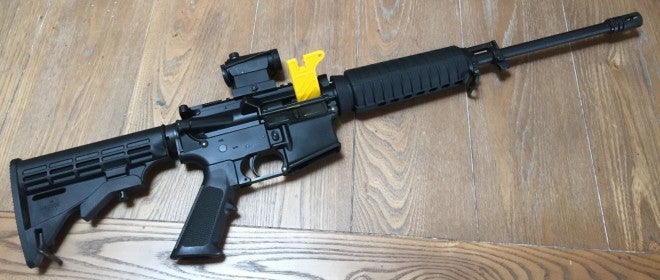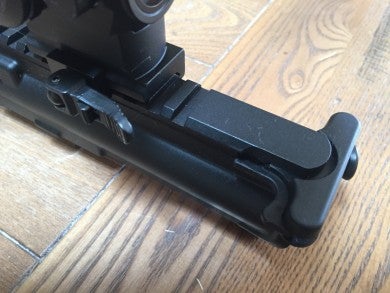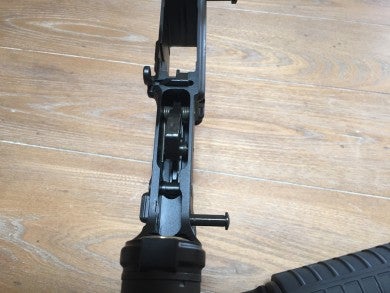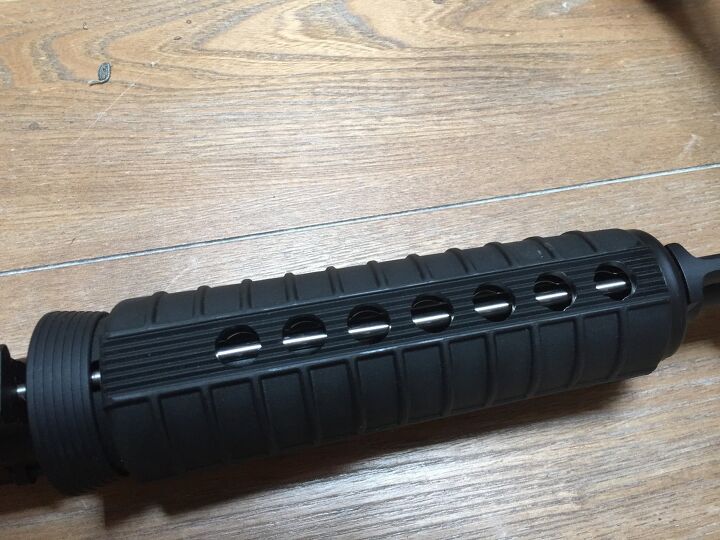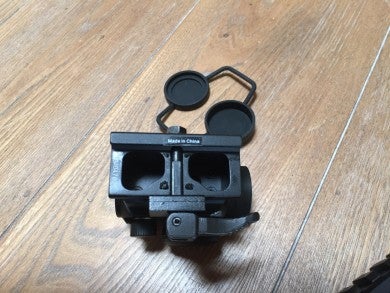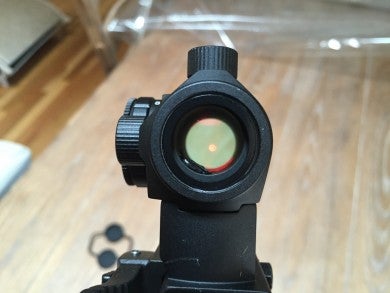Bushmaster XM15 ORC
I don’t remember exactly when I formed the belief that Bushmaster was not a high quality platform. I remember as far back as 1999 not having a high opinion. Certainly at that time I really had NO basis for comparison, and had not had more than a couple hundred rounds through any AR-15 type rifle. I’m assuming that the people I associated with at the time were not fans, and thus I was not a fan.
Now that a I have a few more hours running the platform in general, I think I can make a bit more of an informed opinion about Bushmaster in general, and this rifle specifically.
Construction
I know a lot of you are thinking “ho-hum, yawn”, just another AR. And you would be right. There is definitely a glut of them on the market and at this point the platform is a well understood and prolific item. Really, now, it comes down to the specific components used in the build, and the resulting price of that specific package.
Because of the run on rifles over the past few years, it seems that the market did itself a disservice by trying to race to the bottom with prices. That of course translates to a corresponding drop in quality so that manufactures can still make their meager margins (which then get passed on as even more meager margins to dealers, and so forth).
The XM15 OCR-OR rifle is a pretty standard build with a 16″ chrome-moly barrel. None of the other components were really standout. The rifle had an adjustable stock (six positions). It was pretty novel to me to see regular hand guards and no quad rail, M-Lok or KeyMod. It did have a small section of picatinny, on the top, and was there to accommodate the included optic. The included optic was a basic red dot–not an Aim Point.
Observations
Rather than doing another boring square bay shoot by dumping a couple of magazines at some paper, I decided to play with the Bushmaster at distance. I would hope that any rifle in this class would be consistent at “CQB” ranges. Thomas Gomez has a chunk of land down south where we could effectively shoot a mile if need be—not that there was any expectation of this rifle being remotely able to do that.
At the same time I was also doing a review of an iPhone app “Ballistic (Advanced Edition)” and I figured this would be a good chance to “kill two birds with one stone” (or “two reviews with one range session”).
I ran a magazine of Wolf ammo through it initially just to confirm that it functioned properly. Walt from BMC had kindly donated a box of 75 grain Hornady to play with, so I loaded up a magazine and a half for the test.
Since I was going to run it at distance we added a bottom rail segment with a Harris bipod, and Tom’s Bushnell HDMR (with a Horus H59 reticle), and this was also the first time I had ever shot with anything other than mildot. The rifle did come with a red dot style optic. It was nothing fancy or quality as far as I could tell and it had a HUGE dot (a whopping 3.5 MOA; though I suppose that is somewhat appropriate for a “CQB” optic, perhaps even a bit small).
I set up a shooting platform at twenty meters just to ensure I was close on the target and then started moving back. At a hundred meters for the first few rounds it was not at all consistent, and I was starting to develop a negative opinion about it. Rather than just box it back up and go with a “meh” review, I decided to burn the rest of the box of ammo. I did not do any sort of “break-in” on the rifle (e.g. clean, shoot, clean, shoot, etc.)—this was the first time it had been shot. Anyway, after about eight salvos of three rounds it started tightening up (I had Tom shoot it a couple of times to eliminate the potential that I was the problem). Good enough to get a decent and consistent zero. I went back up to the stand, replaced the paper on the target and headed back out. After confirming, we started moving our line back, roughly one-hundred meters at a time (Tom had a range finder so we were getting as close as possible while finding good shooting positions). We shot on paper out to two-hundred and then started on the steel.
Tom was testing a new scope on his .308 build at the same time so we took turns shooting and spotting. The goal was to go as far back as we could until we both could not get at least one round on steel from a salvo of six (or we ran out of ammo).
Ultimately I was able to hit the steel from six-hundred with three of my last six rounds (for what it is worth, Tom was still going strong with his). I attribute the missed ones to a sudden crosswind (rather than say, anything I was doing…). Call me impressed. I would not have expected to be able to do that with this rifle.
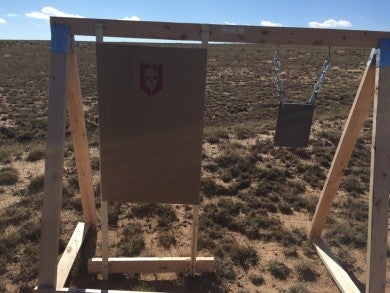
Tom Gomez’s super sweet portable target stand. We started with paper targets on the cardboard for close confirmation. The hanging steel was for our distance shots beyond 200 yards.
One other thing I did note while doing the review was that the adjustable stock was super loose and rattled a bit. Most of the other adjustable stocks I’ve used are pretty tight. I’m not sure if that is a general issue with the model, or the specific stock that was on the rifle—I didn’t have another stock to swap out and check against.
Technical Specifications
Rifle
- Caliber: 5.56 NATO/223 Rem
- Weight: 6 lbs
- Overall Length: 32.5″
- Barrel Length: 16″
- Barrel: 4150 chrome-moly steel w/chrome-lined bore/chamber
- Handguard: Oval M4-type hand guards
- Stock: Six-position “telestock”
- Mounts: Receiver-length Picatinny “optics rail”
- Muzzle Device: A2 birdcage-type flash hider
Optic
- Power/Objective Lens: 1×20
- Length: 2.65”
- Center Height: 40.5mm
- Weight: 6.6 oz
- Dot Size: 3.5 MOA
- Adjustment Range (in@100yds/MOA): 36/35
- Click Value: 1 MOA
- Parallex Setting: 50 yards
- Battery: CR2032
- Brightness Levels: 11
Conclusion
Overall I was pleasantly surprised with the Bushmaster. As I had mentioned, I did not really associate the Bushmaster line with a quality product (and in all fairness I did not actually do destructive testing on it). But we were ringing steel at a hair over six hundred meters. After chatting with my favorite armorer, he indicated that the uppers have always been generally good—it was historically a number of the components in the lower that were problematic (which he demonstrated by pulling broken components from his box of shame; one particularly telling piece was a shattered bolt drop lever).
It will be interesting to see if this rifle suffers from the same problem—Tom G actually just bought one of this exact make and model and tore it apart (because he is a nerd like that) so I was able to get him to contribute some feedback:
- The Barrel nut was not torqued to the minimum 30ft/lbs and I was able to loosen it by hand. The range that the barrel nut should be torqued is 30-80 ft/lbs
- The M4 feed ramps were a bit rough where the barrel extension meets the upper receiver.
- The gas port was .058. There is nothing wrong with a .058 diameter gas port. A gas port this size will run best off mil spec ammunition.
- The taper pins on the gas block were hardened appropriately and did not deform when removed. (Unlike the ones on the POS CORE rifle I recently worked on.)
- The lower receiver was assembled correctly, though I wish Bushmaster would start using the Mil Spec sized receiver extension/buffer tube.
- The CNC work and anodizing on the upper and lower receiver were excellent.
- The bolt carrier group was chromed were appropriate. The gas key was staked appropriately and the fasteners did not move when I tried to move them with an allen key. The ejector was smooth when pushed in and did not hang up. (Unlike the one on the POS CORE rifle I recently worked on.) The extractor had the black insert as well as a Crane o-ring. The gas rings looked good.
- I am confident the Bushmaster will run fairly well. The bolt appeared to be well made, but I always stash a 158 Carpenter bolt from Bravo Company or Colt in the pistol grip as well as gas rings, extractor, extractor spring and firing pin.
Bushmaster does tout a full one-year warranty on the rifle so I imagine they have worked some of the kinks out.
In any case, the Bushmaster XM15 ORC did just fine for a sub $700 (street price I saw on a number of sites) AR15 style rifle, and would make a great starting platform to begin your own customizations.
Note: I normally recommend going to the manufacturer’s website, but Bushmasters looks terribly dated and doesn’t really have much in the way of details (but I included it nonetheless): http://www.bushmaster.com/firearms/XM-15.asp
We are committed to finding, researching, and recommending the best products. We earn commissions from purchases you make using the retail links in our product reviews. Learn more about how this works.
 Your Privacy Choices
Your Privacy Choices
